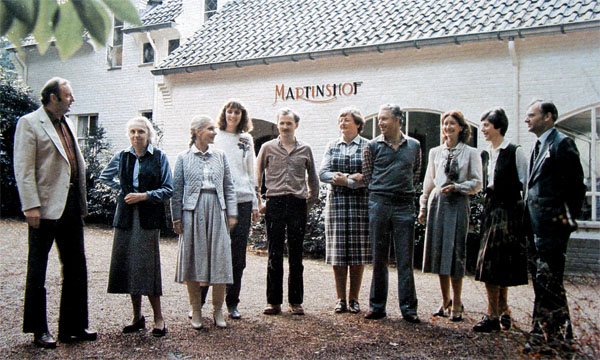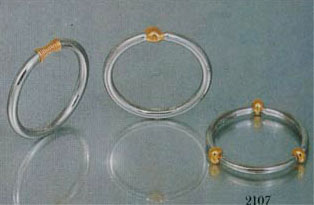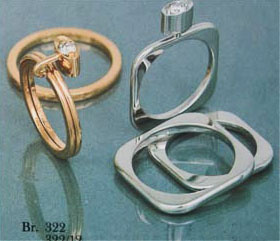|
The Martinshof Story - Page 11
Page | Previous |
Next ||
1 |
2 |
3 |
4 |
5 |
6 |
7 |
8 |
9 |
10 |
11 |
12 |
13 |
14 |
15 |
16 |
? |
Next -
Previous -
Top -
Page 1 -
Photos -
Michael's Blog -
Jazclass Links
40. Cutting our costs without a loss of staff
 After doing my financial estimates for 1982, as Jansen had advised me, it became overly
clear that a large amount of cost cutting was necessary.
After doing my financial estimates for 1982, as Jansen had advised me, it became overly
clear that a large amount of cost cutting was necessary.
Getting rid of two
cars for our office staff to run around in, as well as a few other bits and
pieces was relatively painless.
We also clearly had to get rid of our
Advertising agency (in Hilversum I believe). They were supposed to distribute
the new Niessing catalogues to our customers for us and produce a new Martinshof
brochure, but so far they had done very little and charged the earth for it. I was
not going to take that lying down.
But after that it was clear that we had to reduce our staff by at least two, to
come anywhere near breaking even next year. I went over all the figures with Mrs. de
Jonge and we discussed the situation at length, but always came back to the same
outcome.
The following morning Mrs. de Jonge came into my office, she had not slept a wink all
night, but (with her good understanding of the Dutch employment environment and
regulations) had come up with an alternative idea :
"Mr. Furstner", she said "how about not
reducing our staff by 2, but putting 4 of them on half days work instead ?"
I thought this was a great idea. Our staff had all been with us for a long time and had
expertise I did not want to loose. Putting four of them on half time was feasible in
terms of our present workload. If we would pay them 50% of their salary and the
Government was willing to give them 80% unemployment money for their half day lost,
they would still receive 90% of their present full salary. A pretty good deal under the
circumstances.
 So that is what we decided to go for. We made an appointment with the appropriate
Government official in Zutphen and went to see him. I still remember his face as if it
was yesterday. A kind man with bushy black grey peppered hair and horn rimmed glasses
wearing a dark blue with white dots speckled bow tie.
So that is what we decided to go for. We made an appointment with the appropriate
Government official in Zutphen and went to see him. I still remember his face as if it
was yesterday. A kind man with bushy black grey peppered hair and horn rimmed glasses
wearing a dark blue with white dots speckled bow tie.
He listened to our proposal
attentively, said that it had merit, and that the Government would probably go along
with it provided we could make a sound financial case for it through our accountant.
The fact that he new our chief accountant (Van Dien & Co in Lochem)
personally was also a good sign. So Van Dien prepared the report and we were given the
go ahead from the Government early October 1981.
We had discussed our proposal
earlier already with all our staff and immediately handed out official notices to four
of them, with the assurance that they would be put back on full time when the financial
situation would allow us to do so.
I asked the other staff members to take a 10% salary cut, which they all agreed to,
and took a 20% cut myself.
 A few days later our Senior diamond setter Henny Everts (our only employee with
membership to a Union) came into my office. "Mr. Furstner,
I have had an official letter from my Union, strongly advising me to reject your
offer" he said to me, then continued "Maar ze kunnen de
pot op!" ("they can lick my ....!") "I have been with
Martinshof for a long time. Your proposal is a fair one and the best for all of us
under the circumstances, so I have told my Union that I go along with it."
A few days later our Senior diamond setter Henny Everts (our only employee with
membership to a Union) came into my office. "Mr. Furstner,
I have had an official letter from my Union, strongly advising me to reject your
offer" he said to me, then continued "Maar ze kunnen de
pot op!" ("they can lick my ....!") "I have been with
Martinshof for a long time. Your proposal is a fair one and the best for all of us
under the circumstances, so I have told my Union that I go along with it."
This was a good thing Henny did for us and I was touched and pleased. It also
emphasised the fact that in one sense the Martinshof staff had never really been part of
a company, they had all been part of a family and that this worked both ways.
So the decision had been made and implemented, but it would be a long time yet before the
financial benefit of it would start to have its effect.
Because (according to the regulations) for every year of employment an employee had to
be given 2 additional weeks notice. As most of our staff had been with us for 10 to 15
years this meant that it would take at least 20 weeks before some of them would
actually go on half days work. Henny with 15 years of employment with us, would not go
on half time until mid May 1982.
Next -
Previous -
Top -
Page 1 -
Photos -
Michael's Blog -
Jazclass Links
41. We aquire one of the first "mini computers" ever used in the Netherlands
 One of the first questions I asked Mrs. de Jonge, when I took the reign at Martinshof
mid 1981 was : "How did we do last month?" She and her
assistant Mieke Hauptmeyer worked for two days to come up with the answer. Meanwhile
all other book keeping, including Invoicing, could not be done.
One of the first questions I asked Mrs. de Jonge, when I took the reign at Martinshof
mid 1981 was : "How did we do last month?" She and her
assistant Mieke Hauptmeyer worked for two days to come up with the answer. Meanwhile
all other book keeping, including Invoicing, could not be done.
It highlighted to me
how time consuming and costly accounting was for most businesses in
those days.
Early that year my father had commissioned some Consultants to
investigate the feasibility of using a computer at Martinshof. But their advise
(considering only a large mainframe computer) was negative.
We did have a monster
machine incorporated in a large desk weighing a ton, with which Mieke made once a week
the Invoices but that was all as far as modern technology was concerned.
Then, one day in the latter part of 1981, I walked into Klein Beernink, our
office supply shop (then) located on the Markt in Deventer. A cute little machine
(maybe as large as a small TV) with a glass screen, two large vertical slots on its
right side and a keyboard at the front immediately took my attention. It was one of the
very first 7 mini computers manufactured by Toshiba ever to reach our
Dutch shores.
It ran a comprehensive accounting program all in perfect Dutch
language and I was fascinated by it. After a brief demonstration I told them I would be
back in the afternoon with my bookkeeper. This we did, and Mrs. de Jonge too was
immediately most exited about it. "But", she said, "Van Dien must approve of it. After all, ultimately they are
responsible for all our accounting."
So I spoke to Van Dien in Lochem. They
hummed and hahed, made all sorts of objections, obviously afraid that something might
go wrong. But I pushed until they finally reluctantly gave in. Ignorance of not knowing
what can go wrong can, at least sometimes, be a great bliss!
I think it was sometime in November 1981 that we got our own machine, leased for the
ridiculously low cost of just 40 guilders per month! After a couple of lessons and
demos by the Toshiba staff from Gouda we were up and running. Mrs. de Jonge and I (and
sometimes Mieke too) worked hard and continuously (I often right through the weekend)
to firstly get all our customer details into the program, then input all outstanding
invoices and their details in full. After 6 weeks, on the 1st of January 1982 we
started to process and print new Invoices life on the computer.
We had learned a lot in a very short time and I had made up a check sheet of what had
to be done to close the books at the end of each month. The Toshiba people in Gouda
were most interested in this and asked my permission to use it for their other
customers too. We were clearly at the front of the pack in Holland. In return Toshiba
wrote for us a small program which we could use to keep control of our stock of
diamonds.
It took Mrs. de Jonge another 3 months or so to put in all accounting data of our
company so that by about May I believe we could print out an exact financial situation
report at the end of each month. It was absolutely marvelous!!
Instead of needing 2 bookkeepers full time, we could now handle the same work with
just one person on half days. Mrs. de Jonge was working half days then and Mieke spent
most of her time doing other work.
Next -
Previous -
Top -
Page 1 -
Photos -
Michael's Blog -
Jazclass Links
42. Stock control at Martinshof
 Although there was never any Import Duty on gold and jewelry coming into the
Netherlands, getting new stock from Germany across the border was hampered by red tape
and would take at least 3-5 weeks before it was released.
Although there was never any Import Duty on gold and jewelry coming into the
Netherlands, getting new stock from Germany across the border was hampered by red tape
and would take at least 3-5 weeks before it was released.
Soon after my father
started to import wedding rings from Niessing in Vreden just across the border, he
managed to negotiate a much quicker way with the Dutch Customs Department.
Every
Friday afternoon our order for the following week would be phoned through to Niessing.
Then the following Thursday afternoon someone from Martinshof would drive the 50km to
Vreden, receive at the factory the trays with rings plus all required documentation.The
trays were placed in a metal box (of 30x30x30cm, 1 cubic ft) and driven back to the
border. First the German border official would process and stamp the documents, then the
Dutch officials had their turn. They inspected the merchandise, then closed and sealed the box
with a small lead seal. It was then driven to Martinshof.
The following
morning someone would take the (still sealed) box to the Dutch Government's essay
laboratory in Arnhem, where the rings were essayed and stamped with the Martinshof
master seal. This usually took an hour or two, after which the now unsealed box was
collected and driven back to Martinshof. (Sometime during the 1970s the Arnhem office
was closed and rings had to be essayed in the Central laboratories in Utrecht.) The
whole procedure was done and dusted within a mere 24 hours.
 This procedure was of course marvelous! It enabled Martinshof to maintain a relatively
tight stock, with a wide range of models at hand but not requiring too many items of
each individual model. It enabled Martinshof also to respond to orders of rare models
(not held in stock) rather quickly.
This procedure was of course marvelous! It enabled Martinshof to maintain a relatively
tight stock, with a wide range of models at hand but not requiring too many items of
each individual model. It enabled Martinshof also to respond to orders of rare models
(not held in stock) rather quickly.
With the wide range of models Martinshof kept the ordering at the end of each week
became almost something of an art form, of which Trudy Bergmans was the
absolute master. She was on the phone all week accepting orders and had therefore a
good feel for what went out. At the end of the week she almost intuitively placed the
order for the following week, and I don't think we ever experienced any stock shortage
this way.
When I was in charge during 1981-83 I always felt rather vulnerable with this
situation however, I had to rely too much on the expertise of one single person. As
long as Trudy was there everything went fine, but when she was on holiday or became ill
(she was in hospital for 6 weeks at one stage) we had a problem. I usually called
Marion Turney into the office on such Fridays. With her daily contact with
customers on the road she too had a fair idea what was current, but still I was uneasy.
Then, with our mini computer in working order everything changed. At any time
we could instantly print out lists of sold models and quantities for any period. This
gave us reliable factual data on which we could base our orders. I established a
colour code, stuck on all ring trays which indicated the number of rings we should hold
in stock for each model. So now finally we had a reliable back up ordering system which
anyone could operate. Trudy continued to do her ordering of course, she was good at it.
But we had a reliable safeguard in place to fall back on whenever required. I felt at
ease about the situation at last.
PS
Now in 2010 this may all sound "old hat" of course, but at the time in 1982 we were right at the forefront of these developments. A number of Managers from various companies rang me up about it and visited us to look at our set up. It made me feel rather good I must admit. I had never had any business experience before and found myself after 6 months in the job advising others, who had been in business for years, on a range of aspects!
Next
Copyright © 2010 Michael Furstner
|

 So that is what we decided to go for. We made an appointment with the appropriate
Government official in Zutphen and went to see him. I still remember his face as if it
was yesterday. A kind man with bushy black grey peppered hair and horn rimmed glasses
wearing a dark blue with white dots speckled bow tie.
So that is what we decided to go for. We made an appointment with the appropriate
Government official in Zutphen and went to see him. I still remember his face as if it
was yesterday. A kind man with bushy black grey peppered hair and horn rimmed glasses
wearing a dark blue with white dots speckled bow tie. 
 One of the first questions I asked Mrs. de Jonge, when I took the reign at Martinshof
mid 1981 was : "How did we do last month?" She and her
assistant Mieke Hauptmeyer worked for two days to come up with the answer. Meanwhile
all other book keeping, including Invoicing, could not be done.
One of the first questions I asked Mrs. de Jonge, when I took the reign at Martinshof
mid 1981 was : "How did we do last month?" She and her
assistant Mieke Hauptmeyer worked for two days to come up with the answer. Meanwhile
all other book keeping, including Invoicing, could not be done.
